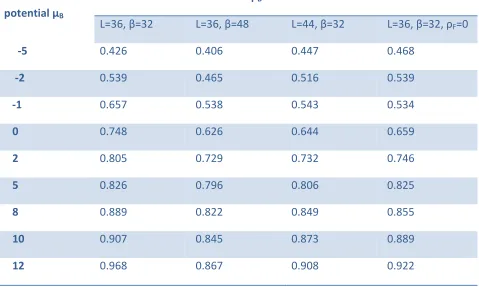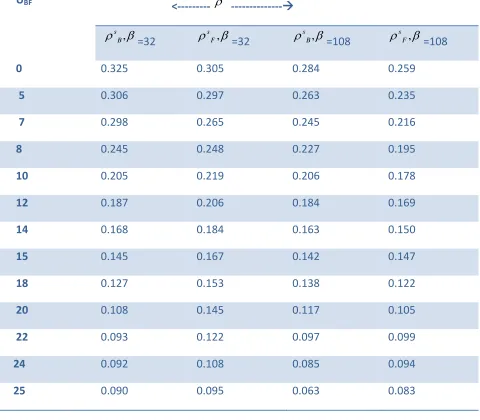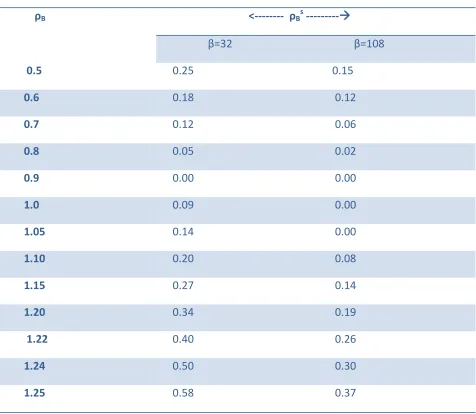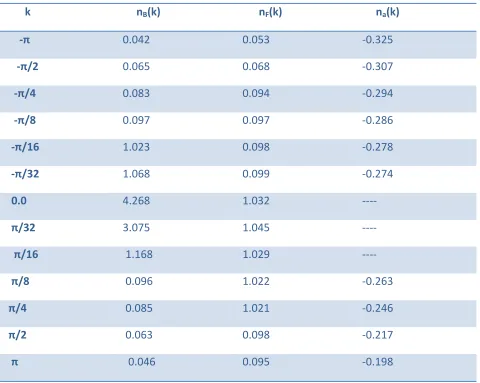Available Online at www.ijpret.com 1
INTERNATIONAL JOURNAL OF PURE AND
APPLIED RESEARCH IN ENGINEERING AND
TECHNOLOGY
A PATH FOR HORIZING YOUR INNOVATIVE WORK
A THEORETICAL EVALUATION OF SUPER FLUID RESPONSE AND
MOMENTUM DISTRIBUTION FUNCTIONS OF ONE-DIMENSIONAL
BOSE-FERMI MIXTURES
SAW P3, VERMA VK2, MISHRA LK1
1. Department of Physics, Magadh University, Bodh-Gaya-824234 (Bihar) 2. Department of Physics, Gaya College Gaya-823001 (Bihar)
3. Department of Physics, J. J. College, Jhumari Tilaya (Koderma) (Jharkhand)
Accepted Date: 18/05/2014; Published Date: 01/10/2014
\
Abstract:Using the theoretical formalism of A. Zujev etal (Phys. RevA, 2008), we have evaluated super fluid Bose and Fermi density as a function of Bose-Bose interaction UBB and Bose- Fermi interaction UBF. Our theoretical results show that both ρBs and ρFs decreases with UBB and UBF which are in good agreement with the other theoretical workers. We have also determined momentum distribution for bosons nB(k), fermion distribution nF(k) and anti-correlated pairing momentum na(k) all as a function of wave vector k, keeping UBB, UBF, temperature β constant and varying boson occupation NB from 20 to 36. Our theoretical results indicate that for lower values of NB, nB(k) attains a peak at k=0 where as nF(k) has plateau at k=0. na(k) shows that composite fermions has been formed by pairing a boson and fermion. For large values of NB, Bose- Fermi mixtures show Mott-insulator phase transition for bosons and Luttinger liquid like behavior for fermions. These observations are in good agreement with other theoretical workers.
Keywords: Strongly correlated systems, Optical lattice, Bose-Hubbard Hamiltonian, Bose-Fermi mixtures, Luttinger liquid, Strong coupling expansion, Bosonization, Quantum Monte Carlo Simulations, anti-correlated pairing momentum
Corresponding Author: MS. PURAN SAW
Access Online On:
www.ijpret.com
How to Cite This Article:
Available Online at www.ijpret.com 2
INTRODUCTION
In recent years, the experimental realization of strongly correlated systems with ultracold gases loaded in optical lattices1 has generated tremendous excitement in condensed matter physics. Among these quantum systems, the realization of Bose-Fermi mixtures in optical lattices2-4, where the inter-and interspecies interactions can be tuned to be attractive or repulsive5 is of remarkable examples. Lot of theoretical studies 6-12 have been performed on Bose-Fermi mixtures for homogeneous and trapped systems. Several approaches were used. Some of them are Gutzwiller mean –field theory13, strong coupling expansions14, bosonization8,9, exact analytical10 and numerical studies11. There was also a study on mixtures of bosonic atoms and molecules on lattice numerically. In these studies, verities of phases were observed in such mixtures. These are Mott insulators, spin and charge density waves, a verity of super fluids, phase separation and Wigner crystals. A study of repulsive Bose-Fermi mixtures in one dimensional lattice has been made where main focused was given on specific special densities. After mapping the phase diagram, one expresses the different sections. The lattice which is half filled with bosons and half filled with fermions has been studied which includes (a) When the number of bosons is commensurate with the lattice size but the number of fermions is not (b) when the sum of both species is commensurate with the lattice size but the number of bosons and fermions are different. Some of the phases present have been identified as Sengupta and Pralka12.
Available Online at www.ijpret.com 3
MATERIALS AND METHODS
The Hamiltonian of Bose-Fermi mixtures in one dimension can be written as
1 1 1 1
( ) ( )
B l l l l l F l l l l l
H t bb b b t ff f f UBBlnBl(nBl 1) UBFln nBl Fl
(1)
Where bl+(bl) are the boson creation (annihilation) operators on site l of one –dimensional lattice with L sites. Similarly fl+(fl) are the creation (annihilation) operators for the spinless fermions on the same lattice sites. For these creation and destruction operators nlB,F are the associated number operators. The bosonic and fermionic hopping parameters are denoted by tB and tF respectively. The on-site boson-boson and boson-fermion interactions are denoted by UBB and UBF respectively. Here, we shall take tB=tF=1(i.e when the boson fermion hopping integrals are equal and one choose tB =1 to set the scale of energy18,19.
One performs the quantum Monte Carlo simulations (QMC) using a recently proposed Canonical Worm algorithm20,21. This approach makes use of global move to update the configurations, samples the winding number and gives access to the measurement of n-body Green’s function. It has also the useful property of working in the Canonical ensemble. This is particularly important for the present applications. Since one is working with two species of particles in the Grand Canonical ensemble. In the Canonical simulations, the Bose and Fermi occupations are exactly specified and the chemical potentials μB and μF are computed via appropriate numerical derivatives of the resultant ground state energy
0 0
[B E N( B 1) E N( B)]
. Here NB is the Boson occupation number and is equal to 3L/4 where L is the lattice site. NF =L/4 and it is fixed.
The Canonical Worm algorithm is a variation of the Prokot’ev etal grand Canonical Worm algorthm18. Within the Canonical Worm approach, one starts by writing the Hamiltonian H= V-T where T is comprised of no diagonal terms and is positive definite. The Partition function Z is given by
H ZTre
It takes the form
0 ( )
T d H
Z Tre Tre
Available Online at www.ijpret.com 4 = 1 1 1 0 .... ( )... ( ) n V
n n n
Tre T T d d
(3) Where( ) V V
T e Te
Here τ is the imaginary time. Now the extended partition function is considered by breaking up the propagator at imaginary time τ and introducing the Worm operator
ijkl ijkl i j k l W b b f f
(4)
This leads to the Partition function
( )
( ) H H
Z Tre We (5)
Complete sets of states are introduced between consecutive T operator to allowed a mapping of the one-dimensional (1D) quantum problem on to a two dimensional (2D) classical problem where a standard Monte Carlo techniques are used. Measurements can be performed when configurations resulting in diagonal matrix elements of W occur. As with pure bosonic systems the evaluation of the boson and fermion densities ρB, ρF with the associated chemical potential μB, μF identifies Mott-insulator behavoir22. A jump in μ signals a Mott phase where the Compressibility B B B F F F
(6)
Vanishes. Here ρB and ρF are the boson and fermion density respectively. One measures the bosonic super fluid density and fermionic stiffness
Available Online at www.ijpret.com 5 Here <W2> are the associated Winding numbers. Correlations between the bosonic and fermionic Winding numbers are determined by the combinations
2
( )
2 s
c B F
L W W 8(a) 2 ( ) 2 s
a B F
L W W 8(b)
In addition to the usual bosonic and fermionic Green’s function
B
ij i j
G b b
9(a)
F
ij i
G f f
9(b)
One also measures the composite anti correlated two-body Green’s function23
a
ij i j j i
G b b f f
(10)
In Gija, the fermion and boson propagates in opposite direction (one from j to i and one from i to j).
The Fourier transforms of GijB and GijF gives the densities nB(k) and nF(k) in momentum space. na(k) is the Fourier transform of the composite two-body Green’s function Gija.
RESULTS AND DISCUSSION:
Available Online at www.ijpret.com 7
CONCLUSION:
In this paper, we have studied the super fluid and Mott-insulator phases of one-dimensional Bose-Fermi mixtures. We have evaluated super fluid boson and fermion density as a function of boson-boson interaction and boson-fermion interaction. We have also evaluated momentum distribution of boson nB(k), fermion nF(k) and anti-correlated pairing momentum na(k) all as a function of k keeping UBF, UBB and temperature β constant and varying NB from 20 to 36. WE observed that boson momentum distribution has a peak where as fermion momentum distribution has a plateau. For large values of nB, na(k) shows that the coupling between bosons and fermions is weak and has phase separation.
Table T1
An evaluated result of boson density ρB as a function of chemical potential μB . The fermion
density ρF =1/4 and the interaction strength are fixed. UBB=10 and UBF=16. We have taken
different lattice size L =36, 44 and temperature β =32 and 48
Chemical
potential μB
<---ρB---
L=36, β=32 L=36, β=48 L=44, β=32 L=36, β=32, ρF=0
-5 0.426 0.406 0.447 0.468
-2 0.539 0.465 0.516 0.539
-1 0.657 0.538 0.543 0.534
0 0.748 0.626 0.644 0.659
2 0.805 0.729 0.732 0.746
5 0.826 0.796 0.806 0.825
8 0.889 0.822 0.849 0.855
10 0.907 0.845 0.873 0.889
Available Online at www.ijpret.com 8
15 1.038 0.898 0.937 0.945
18 1.096 0.925 0.985 0.995
20 1.115 0.996 1.100 1.112
25 1.247 1.105 1.158 1.167
Table T2
An evaluated results of chemical potential μB as a function of boson-fermion interaction
strength UBF for two values of boson density ρB =1.0 and ρB=0.75. Here UBB=10 and ρF =1/4
UBF <--- μB---
ρB =1.0 ρB=0.75
0 16.26 4.86
2 17.48 5.43
5 18.32 6.86
10 19.47 7.98
12 19.82 8.43
14 20.48 9.24
15 21.22 11.67
18 21.47 12.38
20 22.08 13.56
22 22.54 14.34
24 22.84 15.86
Available Online at www.ijpret.com 9
Table T3
An evaluated results of chemical potential μB as a function of boson-boson interaction
strength UBB for two values of boson density ρB =1.0 and ρB=0.75. Here UBF=10 and ρF =1/4
UBB <--- μB---
ρB =1.0 ρB=0.75
0 2.86 2.58
2 4.32 3.27
5 8.34 6.86
10 12.58 11.20
12 14.32 11.38
14 16.59 11.55
15 20.47 11.86
18 25.36 12.05
20 28.58 12.18
22 30.29 12.27
24 33.86 12.58
25 37.58 12.92
Available Online at www.ijpret.com 10
Table T4
An evaluated results of super fluid Bose density and super fluid fermion density with two different temperatures as a function of boson-fermion interaction strength UBF keeping
ρB=3/4 and ρF=1/4, UBB=10
UBF <--- s ---
, s
B
=32 sF, =32 , s
B
=108 sF,=108
0 0.325 0.305 0.284 0.259
5 0.306 0.297 0.263 0.235
7 0.298 0.265 0.245 0.216
8 0.245 0.248 0.227 0.195
10 0.205 0.219 0.206 0.178
12 0.187 0.206 0.184 0.169
14 0.168 0.184 0.163 0.150
15 0.145 0.167 0.142 0.147
18 0.127 0.153 0.138 0.122
20 0.108 0.145 0.117 0.105
22 0.093 0.122 0.097 0.099
24 0.092 0.108 0.085 0.094
25 0.090 0.095 0.063 0.083
Available Online at www.ijpret.com 11
Table T5
An evaluated results of boson super fluid density ρBs as a function of boson density ρB . Here
UBB=0, UBF=16 and ρF= ¼
ρB <--- ρBs ---
β=32 β=108
0.5 0.25 0.15
0.6 0.18 0.12
0.7 0.12 0.06
0.8 0.05 0.02
0.9 0.00 0.00
1.0 0.09 0.00
1.05 0.14 0.00
1.10 0.20 0.08
1.15 0.27 0.14
1.20 0.34 0.19
1.22 0.40 0.26
1.24 0.50 0.30
1.25 0.58 0.37
Available Online at www.ijpret.com 12
Table T6
An evaluated result for momentum distribution of bosons, fermions and anti-correlated pairing momentum as a function of wave vector k Here UBB=10, UBF=16, β=108, NB(occupation
number for bosons)=20
k nB(k) nF(k) na(k)
-π 0.042 0.053 -0.325
-π/2 0.065 0.068 -0.307
-π/4 0.083 0.094 -0.294
-π/8 0.097 0.097 -0.286
-π/16 1.023 0.098 -0.278
-π/32 1.068 0.099 -0.274
0.0 4.268 1.032 ----
π/32 3.075 1.045 ----
π/16 1.168 1.029 ----
π/8 0.096 1.022 -0.263
π/4 0.085 1.021 -0.246
π/2 0.063 0.098 -0.217
π 0.046 0.095 -0.198
Available Online at www.ijpret.com 13
TableT7
An evaluated result for momentum distribution of bosons, fermions and anti-correlated pairing momentum as a function of wave vector k Here UBB=10, UBF=16, β=108, NB(occupation
number for bosons)=27
k nB(k) nF(k) na(k)
-π 0.532 0.325 -0.429
-π/2 0.546 0.337 -0.432
-π/4 0.558 0.348 -0.416
-π/8 0.567 0.353 -0.384
-π/16 0.578 0.362 0.326
-π/32 0.643 0.375 0.472
0.0 1.086 0.392 0.468
π/32 1.079 0.386 0.453
π/16 1.067 0.375 0.286
π/8 1.058 0.352 0.257
π/4 1.048 0.346 -0.263
π/2 1.042 0.338 -0.243
π 1.038 0.325 -0.218
Available Online at www.ijpret.com 14
Table T8
An evaluated result for momentum distribution of bosons, fermions and anti-correlated pairing momentum as a function of wave vector k Here UBB=10, UBF=16, β=108, NB(occupation
number for bosons)=32
k nB(k) nF(k) na(k)
-π 0.534 0.086 -0.057
-π/2 0.675 0.098 -0.042
-π/4 0.786 0.125 -0.038
-π/8 0.997 0.146 -0.029
-π/16 1.532 0.238 0.058
-π/32 2.467 0.295 0.096
0.0 3.456 0.386 0.215
π/32 2.128 0.302 0.187
π/16 1.986 0.295 0.142
π/8 1.643 0.178 0.095
π/4 1.425 0.105 -0.027
π/2 1.184 0.036 -0.038
Available Online at www.ijpret.com 15
TableT9
An evaluated result for momentum distribution of bosons, fermions and anti-correlated pairing momentum as a function of wave vector k Here UBB=10, UBF=16, β=108, NB(occupation
number for bosons)=36
k nB(k) nF(k) na(k)
-π 0.635 0.075 0.086
-π/2 0.746 0.106 0.115
-π/4 0.849 0.198 0.178
-π/8 0.969 0.315 0.256
-π/16 1.124 0.679 0.342
-π/32 1.686 0.735 0.365
0.0 2.147 0.758 0.395
π/32 2.082 0.706 0.312
π/16 1.976 0.325 0.296
π/8 1.842 0.276 0.216
π/4 1.624 0.186 0.135
π/2 1.342 0.098 0.098
Available Online at www.ijpret.com 16
REFERENCE
1. M. Greiner, O. Mandel, T. Esslinger, T. W. Hansh and I. Bloch, Nature (London) 415, 39 (2002)
2. D. Jaksh, C. Bruder, J. I. Cirae, C. W. Gardiner and P. Zoller, Phys. Rev. Lett. (PRL) 81, 3108 (1998)
3. H. Ott, E. de Mirandu, F. Ferlaino, G.Roati, M. Inguscio, Phys. Rev.Lett (PRL) 92,160601 (2004)
4. K. Gunter, T. Staferle, H. Moritz, M. Kohl and T. Esslinger, Phys. Rev. Lett.(PRL) 96, 180402 (2004)
5. S. Opelkaus, C. Ospelkaus, L. Humbert, K. Sengtock and K. Bonger, Phys. Rev. Lett. (PRL) 97, 120403 (2006)
6. M. Zaccanti, C. D. Eerico, F. Ferlaino, G. Roati, M. Inguscio and G. Modugno, Phys. Rev. A 74, 041605 (2006)
7. M. A. Cazalilla and A. F. Ho, Phys. Rev. Lett. (PRL) 91, 150403 (2003)
8. M. Lewenstein, L. Santos, M. A. Baranov and H. Fhrmann, Phys. Rev. Lett. (PRL) 92, 050401 (2004)
9. L. Mathey and D. W. Wang, Phys. Rev. A75, 013612 (2007)
10.A.Imanbekov and E. Demler, Phys. Rev. A73, 021602 (2006)
11.L. Pollet, M. Troyer, K. Van Houcke and S. M. A. Rombouts, Phys. Rev. Lett. (PRL) 96, 190402 (2006)
12.P. Sengupta and L. P. Pryadko, Phys. Rev B75, 132507 (2007)
13.F. Hebert, F. Haudin, L. Pollet and G. G. Batroune, Phys. Rev, A76, 043619 (2007)
14.A. Albus, F. Illuminate and J. Eisert, Phys. Rev. A68, 023606 (2003)
15.A. Zujev, A. Baldwein, R. T. Scalettar, V. G. Rousieau, P. J. H. Dentener and M. Rigol , Phys. A78, 033619 (2008)
Available Online at www.ijpret.com 17 17.G. G. Boljouni, R. T. Scalettar and G. T. Zimanyi, Phys. Rev. Lett. (PRL) 65, 1765 (1990)
18.N. V. Prokof’ev, B. V. Svestunov and I S. Tupetsyn, JETP 87, 310 (1998)
19.M. Cramer, J. Eisert and F. Illumizati, Phys. Rev. Lett. (PRL) 93, 190405 (2004)
20.L. Pollet, C. Kollath, U. Schollwock and M. Troyar, Phys. Rev A77, 023608 (2008)
21.A. Mering and M. Fleischhauer, Phys. Rev A77, 023601 (2008)
22.V. G. Roussean and P. J. H. Denteneer, Phys. Rev. A77, 013609 (2008)
23.J. Bloch, J. Dalibard and W. Zwerger, Rev. Mod. Phys. 80, 885 (2008)
24.A. Schirotzek, C-H Wu and M. W. Zwierlein, Phys. Rev. Lett. (PRL) 102, 230402 (2009)
25.E. Fratini and P. Pieri, Phys. Rev. A81, 051605 (2010)
26.C. Mora and F. Chevy, Phys. Rev. Lett. (PRL) 104, 230408 (2010)
27.Z. Yu, S. Zollner and C. J. Pethick, Phys. Rev. Lett. (PRL) 105, 188901 (2010)
28.C. H. Wu, I. Santiago, J. W. Park and M. W. Zwierlien, Phys. Rev. A84, 011601 (2011)
29.Z. Hadzibabic and J. Dalibard, Riv. Nuovo Cimento, 34, 389 (2011)
30.M. S. Heo, T. T. Wang, C. A. Christensen and W. Ketterle, Phys. Rev. A86, 021602 (2012)
31.C. H. Wu, J. W. Park, P. Ahmedi, S. Wall and M. W. Zwierlean, Phys. Rev. Lett. (PRL) 109, 085301 (2012)





